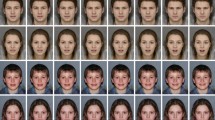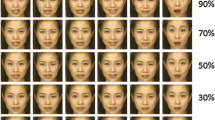Abstract
Accumulating studies have reported facial emotion recognition or facial perception impairments in autism spectrum disorder (ASD). To clarify the specificity of the emotion recognition impairment, this study examined the relationships between facial emotion recognition and facial perception abilities in ASD. Twenty-two adolescents with high-functioning ASD (20 males) and 22 typically developing (TD) adolescents (16 males) aged 11–18 years undertook a facial emotion labeling task and a facial perception test. We found that adolescents with ASD had deficits in recognizing negative facial expressions, which correlated with both facial perception deficits and severity of social impairment. In addition, the emotion recognition deficits remained after adjusting for facial perception performance. Thus, our findings suggest an emotion-specific impairment in facial emotion recognition in ASD.



Similar content being viewed by others
References
Adolphs, R. (2002). Neural systems for recognizing emotion. Current Opinion in Neurobiology, 12(2), 169–177.
American Psychiatric Association. (2013). Diagnostic and statistical manual of mental disorders (5th ed.). Arlington: American Psychiatric Publishing.
Annaz, D., Karmiloff-Smith, A., Johnson, M. H., & Thomas, M. S. (2009). A cross-syndrome study of the development of holistic face recognition in children with autism, Down syndrome, and Williams syndrome. Journal of Experimental Child Psychology, 102(4), 456–486.
Ashwin, C., Chapman, E., Colle, L., & Baron-Cohen, S. (2006). Impaired recognition of negative basic emotions in autism: A test of the amygdala theory. Social Neuroscience, 1(3–4), 349–363.
Bachevalier, J., & Loveland, K. A. (2006). The orbitofrontal–amygdala circuit and self-regulation of social–emotional behavior in autism. Neuroscience & Biobehavioral Reviews, 30(1), 97–117.
Bal, E., Harden, E., Lamb, D., Van Hecke, A. V., Denver, J. W., & Porges, S. W. (2010). Emotion recognition in children with autism spectrum disorders: Relations to eye gaze and autonomic state. Journal of Autism and Developmental Disorders, 40(3), 358–370.
Batty, M., & Taylor, M. J. (2003). Early processing of the six basic facial emotional expressions. Cognitive Brain Research, 17(3), 613–620.
Benton, A. L., Sivan, A. B., Hamsher, K., Varney, N. R., & Spreen, O. (1994). Contributions to neuropsychological assessment: A clinical manual (2nd ed.). New York: Oxford University Press.
Calvo, M. G., & Lundqvist, D. (2008). Facial expressions of emotion (KDEF): Identification under different display-duration conditions. Behavior Research Methods, 40(1), 109–115.
Cohen, J. (1973). Eta-squared and partial eta-squared in fixed factor ANOVA designs. Educational and Psychological Measurement, 33(1), 107–112.
Cohen J. (1988). Statistical power analysis for the behavioral sciences. New York, NY: Routledge Academic.
Constantino, J. N., & Gruber, C. P. (2012). Social responsiveness scale (SRS). Torrance: Western Psychological Services.
Dawson, G., Toth, K., Abbott, R., Osterling, J., Munson, J., Estes, A., & Liaw, J. (2004). Early social attention impairments in autism: social orienting, joint attention, and attention to distress. Developmental Psychology, 40(2), 271–283.
Eack, S. M., Mazefsky, C. A., & Minshew, N. J. (2015). Misinterpretation of facial expressions of emotion in verbal adults with autism spectrum disorder. Autism, 19(3), 308–315.
Ekman, P. (1992). An argument for basic emotions. Cognition & Emotion, 6(3–4), 169–200.
Enticott, P. G., Kennedy, H. A., Johnston, P. J., Rinehart, N. J., Tonge, B. J., Taffe, J. R., & Fitzgerald, P. B. (2014). Emotion recognition of static and dynamic faces in autism spectrum disorder. Cognition and Emotion, 28(6), 1110–1118.
Falkmer, T., Anderson, K., Falkmer, M., & Horlin, C. (2013). Diagnostic procedures in autism spectrum disorders: A systematic literature review. European Child & Adolescent Psychiatry, 22(6), 329–340.
Fein, D., Barton, M., Eigsti, I. M., Kelley, E., Naigles, L., Schultz, R. T., … Troyb, E. (2013). Optimal outcome in individuals with a history of autism. Journal of Child Psychology and Psychiatry, 54(2), 195–205.
Garman, H. D., Spaulding, C. J., Webb, S. J., Mikami, A. Y., Morris, J. P., & Lerner, M. D. (2016). Wanting it too much: An inverse relation between social motivation and facial emotion recognition in autism spectrum disorder. Child Psychiatry & Human Development, 47(6), 890–902.
Goeleven, E., De Raedt, R., Leyman, L., & Verschuere, B. (2008). The Karolinska directed emotional faces: A validation study. Cognition and Emotion, 22(6), 1094–1118.
Griffiths, S., Jarrold, C., Penton-Voak, I. S., Woods, A. T., Skinner, A. L., & Munafò, M. R. (2017). Impaired recognition of basic emotions from facial expressions in young people with autism spectrum disorder: Assessing the importance of expression intensity. Journal of Autism and Developmental Disorders. https://doi.org/10.1007/s10803-017-3091-7.
Harms, M. B., Martin, A., & Wallace, G. L. (2010). Facial emotion recognition in autism spectrum disorders: a review of behavioral and neuroimaging studies. Neuropsychology Review, 20(3), 290–322.
Hooker, C., & Park, S. (2002). Emotion processing and its relationship to social functioning in schizophrenia patients. Psychiatry Research, 112(1), 41–50.
Humphreys, K., Minshew, N., Leonard, G. L., & Behrmann, M. (2007). A fine-grained analysis of facial expression processing in high-functioning adults with autism. Neuropsychologia, 45(4), 685–695.
Izard, C., Fine, S., Schultz, D., Mostow, A., Ackerman, B., & Youngstrom, E. (2001). Emotion knowledge as a predictor of social behavior and academic competence in children at risk. Psychological Science, 12(1), 18–23.
Jones, C. R., Pickles, A., Falcaro, M., Marsden, A. J., Happé, F., Scott, S. K., … Simonoff, E. (2011). A multimodal approach to emotion recognition ability in autism spectrum disorders. Journal of Child Psychology and Psychiatry, 52(3), 275–285.
Just, M. A., Keller, T. A., Malave, V. L., Kana, R. K., & Varma, S. (2012). Autism as a neural systems disorder: A theory of frontal-posterior underconnectivity. Neuroscience & Biobehavioral Reviews, 36(4), 1292–1313.
Kennedy, D. P., & Adolphs, R. (2012). Perception of emotions from facial expressions in high-functioning adults with autism. Neuropsychologia, 50(14), 3313–3319.
Keppel G. (1991). Design and analysis: A researcher’s handbook. Englewood Cliffs, NJ: Prentice Hall.
Kuusikko, S., Haapsamo, H., Jansson-Verkasalo, E., Hurtig, T., Mattila, M. L., Ebeling, H., … Moilanen, I. (2009). Emotion recognition in children and adolescents with autism spectrum disorders. Journal of Autism and Developmental Disorders, 39(6), 938–945.
Lord, C., Rutter, M., & Le Couteur, A. (1994). Autism diagnostic interview-revised: A revised version of a diagnostic interview for caregivers of individuals with possible pervasive developmental disorders. Journal of Autism and Developmental Disorders, 24(5), 659–685.
Lundqvist, D., Flykt, A., & Öhman, A. (1998). The Karolinska directed emotional faces (KDEF). CD ROM from Department of Clinical Neuroscience, Psychology section, Karolinska Institutet, ISBN 91-630-7164-9.
Mandal, M. K., Tandon, S. C., & Asthana, H. S. (1991). Right brain damage impairs recognition of negative emotions. Cortex, 27(2), 247–253.
McPartland, J. C., Webb, S. J., Keehn, B., & Dawson, G. (2011). Patterns of visual attention to faces and objects in autism spectrum disorder. Journal of Autism and Developmental Disorders, 41(2), 148–157.
Pelphrey, K. A., Sasson, N. J., Reznick, J. S., Paul, G., Goldman, B. D., & Piven, J. (2002). Visual scanning of faces in autism. Journal of Autism and Developmental Disorders, 32(4), 249–261.
Picci, G., & Scherf, K. S. (2016). From caregivers to peers: Puberty shapes human face perception. Psychological Science, 27(11), 1461–1473
Philip, R. C. M., Whalley, H. C., Stanfield, A. C., Sprengelmeyer, R., Santos, I. M., Young, A. W., … Hall, J. (2010). Deficits in facial, body movement and vocal emotional processing in autism spectrum disorders. Psychological Medicine, 40(11), 1919–1929.
Renneberg, B., Heyn, K., Gebhard, R., & Bachmann, S. (2005). Facial expression of emotions in borderline personality disorder and depression. Journal of Behavior Therapy and Experimental Psychiatry, 36(3), 183–196.
Sachse, M., Schlitt, S., Hainz, D., Ciaramidaro, A., Walter, H., Poustka, F., … Freitag, C. M. (2016). Facial emotion recognition in paranoid schizophrenia and autism spectrum disorder. Schizophrenia Research, 159 (2), 509–514.
Schultz, R. T. (2005). Developmental deficits in social perception in autism: the role of the amygdala and fusiform face area. International Journal of Developmental Neuroscience, 23(2–3), 125–141.
Uljarevic, M., & Hamilton, A. (2013). Recognition of emotions in autism: A formal meta-analysis. Journal of Autism and Developmental Disorders, 43(7), 1517–1526.
Veale, J. F. (2014). Edinburgh handedness inventory–short form: A revised version based on confirmatory factor analysis. Laterality: Asymmetries of Body, Brain and Cognition, 19(2), 164–177.
Vetter, N. C., Drauschke, M., Thieme, J., & Altgassen, M. (2018). Adolescent basic facial emotion recognition is not influenced by puberty or own-age bias. Frontiers in Psychology, 9, 956.
Wagner, H. L. (1993). On measuring performance in category judgment studies of nonverbal behavior. Journal of Nonverbal Behavior, 17(1), 3–28.
Wallace, S., Coleman, M., & Bailey, A. (2008). Face and object processing in autism spectrum disorders. Autism Research, 1(1), 43–51.
Wechsler, D. (2010). Wechsler Intelligence Scale for Children (4th ed.). Hong Kong: King-May Psychological Assessment.
Weigelt, S., Koldewyn, K., & Kanwisher, N. (2012). Face identity recognition in autism spectrum disorders: A review of behavioral studies. Neuroscience & Biobehavioral Reviews, 36(3), 1060–1084.
Wolf, J. M., Tanaka, J. W., Klaiman, C., Cockburn, J., Herlihy, L., Brown, C., … Schultz, R. T. (2008). Specific impairment of face-processing abilities in children with autism spectrum disorder using the Let’s Face It! skills battery. Autism Research, 1(6), 329–340.
Yeung, M. K., Han, Y. M., Sze, S. L., & Chan, A. S. (2014). Altered right frontal cortical connectivity during facial emotion recognition in children with autism spectrum disorders. Research in Autism Spectrum Disorders, 8(11), 1567–1577.
Acknowledgments
The authors would like to thank Buddhist Tai Hung College, Chi Lin Buddhist Secondary School, Heep Hong Society, New Life Psychiatric Rehabilitation Association, City of Love, and Parents’ Association of Pre-school Handicapped Children for their assistance in subject recruitment. Appreciation is extended to all adolescents and parents who participated in this research project.
Author information
Authors and Affiliations
Contributions
MY contributed to the conceptualization of the study. MY and TL contributed to the subject recruitment and data collection. MY undertook the data analysis and prepared the initial draft of the manuscript. MY, TL, and AC significantly contributed to the later versions of the manuscript, and read and approved the final version of the manuscript.
Corresponding author
Ethics declarations
Conflict of interest
The authors declare that they have no conflict of interest.
Ethical Approval
All procedures performed in studies involving human participants were in accordance with the ethical standards of the institutional and/or national research committee and with the 1964 Helsinki declaration and its later amendments or comparable ethical standards.
Informed Consent
Informed consent was obtained from all individual participants included in the study.
Additional information
Publisher’s Note
Springer Nature remains neutral with regard to jurisdictional claims in published maps and institutional affiliations.
Rights and permissions
About this article
Cite this article
Yeung, M.K., Lee, T.L. & Chan, A.S. Impaired Recognition of Negative Facial Expressions is Partly Related to Facial Perception Deficits in Adolescents with High-Functioning Autism Spectrum Disorder. J Autism Dev Disord 50, 1596–1606 (2020). https://doi.org/10.1007/s10803-019-03915-3
Published:
Issue Date:
DOI: https://doi.org/10.1007/s10803-019-03915-3




